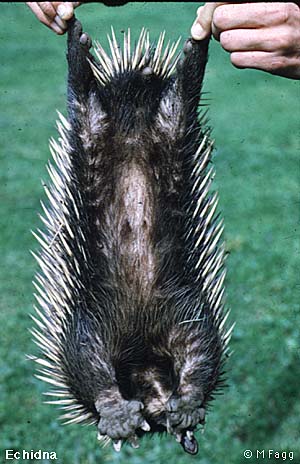Echidnas are sometimes referred to as spiny anteaters which resemble the Hedgehog and the Porcupine in that they are covered by sharp spines. The Echidna is found all over Australia and can survive a range of temperatures and habitats. Though mostly nocturnal, in mild weather they can be seen during the day, but if the weather is extreme (either very cold or hot). Echidnas will stay in shelter (under rocks, fallen timber or burying themselves in the ground).
Description
 An Echidna's body is covered with 2 types of hair. A "normal" short coarse hair to keep them warm and long sharp spines each being a single hair but hard(similar to our fingernails in composition).
An Echidna's body is covered with 2 types of hair. A "normal" short coarse hair to keep them warm and long sharp spines each being a single hair but hard(similar to our fingernails in composition).The colouring and length of their "normal" hair differs wildly across Australia depending on climate and habitat. In size Echidnas are between 35 - 45cms long and weigh anything between 2-7 kg.
The Echidna has a pointy snout and an extremely long sticky tongue to catch ants and termites.
The Echidnas feet have sharp claws for digging and though like the Platypus the male has a spur on its ankle, it is not poisonous. They make a sniffing noise as they search for food.
Habitat & Location
The Echidnas main requirement is a large supply of ants and termites so Echidnas are found all over Australia from the highlands to deserts to forests. The Echidna has no fixed home except when the female is suckling its young. Echidnas can be found in a variety of shelters from rocks to fallen wood, small caves, or even under bushes.Feeding
Normally the Echidna feeds at night on ants or termites. The tip of its snout or nose is sensitive to electrical signals from an insect body thus it searches and "sniffs" out ant and termite nests. Echidnas then normally tears into the mound or nest with its sharp claws (front feet) and its snout exposing the ants or termites and then catching them with its fast flicking sticky tongue. Because they have no teeth the Echidna crushes the insects between horny pads in its mouth.
The tip of its snout or nose is sensitive to electrical signals from an insect body thus it searches and "sniffs" out ant and termite nests. Echidnas then normally tears into the mound or nest with its sharp claws (front feet) and its snout exposing the ants or termites and then catching them with its fast flicking sticky tongue. Because they have no teeth the Echidna crushes the insects between horny pads in its mouth.
Breeding
The female Echidna develops a pouch at the start of the mating season which occurs in July and August. 3 weeks or so after matting the female digs a burrow and lays 1 soft leathery like egg into this pouch.
No comments:
Post a Comment